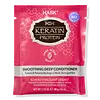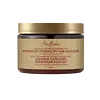What's inside
What's inside
 Key Ingredients
Key Ingredients

No key ingredients
 Benefits
Benefits

 Concerns
Concerns

 Ingredients Side-by-side
Ingredients Side-by-side

Water
Skin ConditioningCetearyl Alcohol
EmollientCetrimonium Chloride
AntimicrobialQuaternium-18
Lanolin
EmollientCetyl Alcohol
EmollientKeratin Amino Acids
Skin ConditioningCocoyl Hydrolyzed Keratin
CleansingCocoyl Hydrolyzed Collagen
CleansingHydrolyzed Collagen
EmollientCocos Nucifera Oil
MaskingHydroxypropyltrimonium Hydrolyzed Rice Protein/Siloxysilicate
Oryza Sativa Extract
AbsorbentSimmondsia Chinensis Seed Oil
EmollientLeuconostoc/Radish Root Ferment Filtrate
AntimicrobialPopulus Tremuloides Bark Extract
AntiseborrhoeicCitric Acid
BufferingGlycerin
HumectantPanthenyl Hydroxypropyl Steardimonium Chloride
Isopropyl Palmitate
EmollientTetrasodium Glutamate Diacetate
Ethylhexylglycerin
Skin ConditioningPhenoxyethanol
PreservativeButylene Glycol
HumectantChlorphenesin
AntimicrobialSodium Benzoate
MaskingParfum
MaskingHexyl Cinnamal
PerfumingWater, Cetearyl Alcohol, Cetrimonium Chloride, Quaternium-18, Lanolin, Cetyl Alcohol, Keratin Amino Acids, Cocoyl Hydrolyzed Keratin, Cocoyl Hydrolyzed Collagen, Hydrolyzed Collagen, Cocos Nucifera Oil, Hydroxypropyltrimonium Hydrolyzed Rice Protein/Siloxysilicate, Oryza Sativa Extract, Simmondsia Chinensis Seed Oil, Leuconostoc/Radish Root Ferment Filtrate, Populus Tremuloides Bark Extract, Citric Acid, Glycerin, Panthenyl Hydroxypropyl Steardimonium Chloride, Isopropyl Palmitate, Tetrasodium Glutamate Diacetate, Ethylhexylglycerin, Phenoxyethanol, Butylene Glycol, Chlorphenesin, Sodium Benzoate, Parfum, Hexyl Cinnamal
Water
Skin ConditioningCetearyl Alcohol
EmollientCocos Nucifera Oil
MaskingButyrospermum Parkii Butter
Skin ConditioningGlycerin
HumectantStearyl Alcohol
EmollientBehentrimonium Methosulfate
Cetyl Alcohol
EmollientParfum
MaskingBehentrimonium Chloride
PreservativePanthenol
Skin ConditioningMangifera Indica Seed Butter
Skin ConditioningTrichilia Emetica Seed Butter
EmollientAdansonia Digitata Seed Oil
EmollientHydrolyzed Rice Protein
Skin ConditioningHydrogenated Vegetable Oil
EmollientPersea Gratissima Oil
Skin ConditioningTocopheryl Acetate
AntioxidantHoney
HumectantCetrimonium Chloride
AntimicrobialFicus Carica Fruit/Leaf Extract
Skin ConditioningTocopherol
AntioxidantGlycine Soja Oil
EmollientPropanediol
SolventCaprylyl Glycol
EmollientCaprylhydroxamic Acid
Benzoic Acid
MaskingWater, Cetearyl Alcohol, Cocos Nucifera Oil, Butyrospermum Parkii Butter, Glycerin, Stearyl Alcohol, Behentrimonium Methosulfate, Cetyl Alcohol, Parfum, Behentrimonium Chloride, Panthenol, Mangifera Indica Seed Butter, Trichilia Emetica Seed Butter, Adansonia Digitata Seed Oil, Hydrolyzed Rice Protein, Hydrogenated Vegetable Oil, Persea Gratissima Oil, Tocopheryl Acetate, Honey, Cetrimonium Chloride, Ficus Carica Fruit/Leaf Extract, Tocopherol, Glycine Soja Oil, Propanediol, Caprylyl Glycol, Caprylhydroxamic Acid, Benzoic Acid
 Reviews
Reviews

Ingredients Explained
These ingredients are found in both products.
Ingredients higher up in an ingredient list are typically present in a larger amount.
Cetearyl alcohol is a mixture of two fatty alcohols: cetyl alcohol and stearyl alcohol. It is mainly used as an emulsifier. Emulsifiers help prevent the separation of oils and products. Due to its composition, it can also be used to thicken a product or help create foam.
Cetearyl alcohol is an emollient. Emollients help soothe and hydrate the skin by trapping moisture.
Studies show Cetearyl alcohol is non-toxic and non-irritating. The FDA allows products labeled "alcohol-free" to have fatty alcohols.
This ingredient is usually derived from plant oils such as palm, vegetable, or coconut oils. There is debate on whether this ingredient will cause acne.
Due to the fatty acid base, this ingredient may not be Malassezia folliculitis safe.
Learn more about Cetearyl AlcoholThis ingredient is a preservative, antimicrobial, and emulsifier. It is often used in cosmetics for its ability to cleanse, condition, and reduce static.
Cetrimonium chloride is a quaternary ammonium salt, meaning it has a water-soluble structure.
Cetyl Alcohol is a fatty alcohol. Fatty Alcohols are most often used as an emollient or to thicken a product.
Its main roles are:
Though it has "alcohol" in the name, it is not related to denatured alcohol or ethyl alcohol.
The FDA allows products labeled "alcohol-free" to have fatty alcohols.
Learn more about Cetyl AlcoholCocos Nucifera Oil is obtained from the kernels of the coconut fruit. In other words, this is coconut oil.
Coconut Oil is rich in fatty acids with lauric acid making up the majority of these. It also contains linoleic acid. Due to this high fatty acid content, coconut oil helps trap moisture and soften skin.
Despite being antibacterial, coconut oil may not be great for acne-prone skin. It is comedogenic and may clog pores. This ingredient may not be safe for malassezia or fungal acne.
Note: Coconut Oil should not replace your sunscreen for UV protection. Studies show it only blocks about 20% of UV.
This oil is non-volatile and has a light scent.
The term 'fragrance' is not regulated in many countries. In many cases, it is up to the brand to define this term. For instance, many brands choose to label themselves as "fragrance-free" because they are not using synthetic fragrances. However, their products may still contain ingredients such as essential oils that are considered a fragrance.
Learn more about Cocos Nucifera OilGlycerin is already naturally found in your skin. It helps moisturize and protect your skin.
A study from 2016 found glycerin to be more effective as a humectant than AHAs and hyaluronic acid.
As a humectant, it helps the skin stay hydrated by pulling moisture to your skin. The low molecular weight of glycerin allows it to pull moisture into the deeper layers of your skin.
Hydrated skin improves your skin barrier; Your skin barrier helps protect against irritants and bacteria.
Glycerin has also been found to have antimicrobial and antiviral properties. Due to these properties, glycerin is often used in wound and burn treatments.
In cosmetics, glycerin is usually derived from plants such as soybean or palm. However, it can also be sourced from animals, such as tallow or animal fat.
This ingredient is organic, colorless, odorless, and non-toxic.
Glycerin is the name for this ingredient in American English. British English uses Glycerol/Glycerine.
Learn more about GlycerinParfum is a catch-all term for an ingredient or more that is used to give a scent to products.
Also called "fragrance", this ingredient can be a blend of hundreds of chemicals or plant oils. This means every product with "fragrance" or "parfum" in the ingredients list is a different mixture.
For instance, Habanolide is a proprietary trade name for a specific aroma chemical. When used as a fragrance ingredient in cosmetics, most aroma chemicals fall under the broad labeling category of “FRAGRANCE” or “PARFUM” according to EU and US regulations.
The term 'parfum' or 'fragrance' is not regulated in many countries. In many cases, it is up to the brand to define this term.
For instance, many brands choose to label themselves as "fragrance-free" because they are not using synthetic fragrances. However, their products may still contain ingredients such as essential oils that are considered a fragrance by INCI standards.
One example is Calendula flower extract. Calendula is an essential oil that still imparts a scent or 'fragrance'.
Depending on the blend, the ingredients in the mixture can cause allergies and sensitivities on the skin. Some ingredients that are known EU allergens include linalool and citronellol.
Parfum can also be used to mask or cover an unpleasant scent.
The bottom line is: not all fragrances/parfum/ingredients are created equally. If you are worried about fragrances, we recommend taking a closer look at an ingredient. And of course, we always recommend speaking with a professional.
Learn more about ParfumWater. It's the most common cosmetic ingredient of all. You'll usually see it at the top of ingredient lists, meaning that it makes up the largest part of the product.
So why is it so popular? Water most often acts as a solvent - this means that it helps dissolve other ingredients into the formulation.
You'll also recognize water as that liquid we all need to stay alive. If you see this, drink a glass of water. Stay hydrated!
Learn more about Water